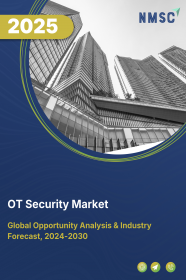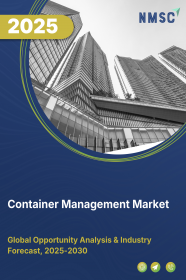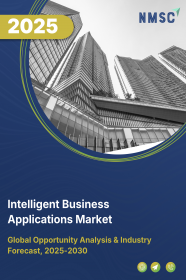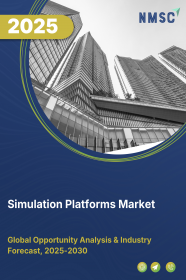
OT Security Market by Component (Solutions (Endpoint Security, Security Information & Event Management (SIEM), IAM, and Others) and Services), by Deployment (Cloud, On-Premise, and Hybrid), by Enterprise Size (SMEs and Large Enterprises) and by End-Users (Power Generation & Electrical, Logistics & Supply chain, Petrochemical, Steel and Metallurgy, Transportation, Mining, Healthcare, Oil & Gas, BFSI, and Others)- Global Opportunity Analysis and Industry Forecast 2025-2030
US Tariff Impact on OT Security Market
Trump Tariffs Are Reshaping Global Business
Operational Technology (OT) Security Market Overview
The global OT Security Market size was valued at USD 24.67 billion in 2024 and is predicted to reach USD 95.06 billion by 2030 with a CAGR of 25.5% from 2025-2030
The operational technology (OT) security industry is experiencing robust growth driven by the convergence of IT and OT systems, which enhances efficiency but exposes critical infrastructure to cyber risks, necessitating robust security solutions.
Escalating cyberattacks targeting sectors like energy and manufacturing, coupled with high-profile incidents, are propelling investments in OT security to safeguard operations. Stringent regulations, such as ISA/IEC 62443 and EU NIS2 Directive, further accelerate adoption by mandating compliance. While legacy OT systems pose challenges due to their outdated technology and high retrofitting costs. However, the development of tailored OT security solutions presents significant opportunities to address these challenges and drive market expansion.
IT/OT Convergence Fuels the Demand for OT Security
The integration of IT and OT systems is a primary catalyst for the market growth. Traditionally isolated OT environments, which manage industrial control systems (ICS) and critical infrastructure, are now interconnected with enterprise IT networks to enhance operational efficiency and enable data-driven decision-making. According to Deloitte, this convergence increases productivity but exposes OT systems to cyber risks previously confined to IT environments. The market size is expanding as organizations invest in solutions to secure this complex ecosystem, with Gartner forecasting the global operational technology security market to grow at a CAGR of 18.5% through 2027, driven by the need for secure IT-OT integration. This convergence is reshaping industrial operations, making robust OT security indispensable for sustainable growth.
A Rising Tide of Cyber Threats Against Critical Operations Propels the OT Security Market Growth
The increasing frequency and sophistication of cyberattacks targeting OT environments and ICS are significant drivers of the industry. Critical sectors such as energy, transportation, and manufacturing face threats from state-sponsored actors, ransomware groups, and other malicious entities.
The IEA highlights that cyberattacks on energy grids could disrupt global energy supply chains, with potential economic losses in the billions. High-profile incidents, such as the 2021 Colonial Pipeline ransomware attack, have heightened awareness, prompting organizations to bolster their operational technology security investments.
McKinsey estimates that cybersecurity spending in industrial sectors will increase by 15% annually through 2030 to mitigate risks to operational continuity and safety. Protecting critical operations from these evolving threats is a cornerstone of the market expansion.
Stringent Regulatory Frameworks Acts as a Catalyst for the OT Security Market Demand
Stringent regulatory frameworks are accelerating the adoption of OT security measures. Standards such as ISA/IEC 62443, NERC CIP, and EU NIS2 Directive mandate robust security practices for critical infrastructure. PwC reports that 70% of industrial organizations cite compliance as a top driver for cybersecurity investments.
Non-compliance can result in hefty fines and reputational damage, making adherence to regulations a priority. The World Bank notes that governments worldwide are increasing investments in cybersecurity regulations to protect national infrastructure, further boosting the market share. Such compliance is not just a mandate but a strategic enabler for market growth.
Legacy Systems Pose a Security Hurdle for the OT Security Market Expansion
The prevalence of legacy OT systems remains a significant challenge for the market. Many industrial systems, with lifespans of 10-20 years, lack modern security features and are vulnerable to exploitation. Bain & Company estimates that 60% of industrial control systems globally rely on outdated technology, complicating the implementation of advanced security measures.
Retrofitting these systems is costly and risks operational disruptions, as highlighted by KPMG. The IEC 62351 standard provides guidance for securing legacy systems, but adoption remains slow due to high costs and technical complexities. Such legacy system hinders the market expansion at global level.
Developing Purpose-Built OT Security Solutions Presents Lucrative Opportunity for the Market Growth
The development of tailored OT security solutions presents a significant growth opportunity. Unlike IT security tools, OT-specific solutions prioritize asset visibility, real-time threat detection, and secure IT-OT convergence without compromising system reliability. Accenture projects that the demand for OT-specific cybersecurity tools will drive a USD12 billion market opportunity by 2028.
Leading vendors are launching innovative solutions to address these needs. For instance, in March 2025, Nozomi Networks introduced its Guardian Air, a wireless operational technology security platform designed for real-time threat detection in industrial environments, as reported by Gartner.
Similarly, Tenable launched its operational technology security 3.0 solution in February 2025, enhancing vulnerability management for ICS. These advancements, coupled with services like OT risk assessments and managed security services, are expected to propel the industry size.
Market Segmentations and Scope of the Study
The OT security market report is segmented on the basis of component, deployment, enterprise size, end-users, and region. On the basis of component, the market is divided into solutions and services. Solutions are further divided into endpoint security, security information and event management (SIEM), identity and access management (IAM), and others. Services are further segmented into consulting services, integration services, and support and maintenance. On the basis of deployment, the market is classified into cloud, on-premise, and hybrid. On the basis of enterprise size, the market is divided into SMEs and large enterprises. On the basis of end-users, the market is segmented into power generation & electrical, logistics & supply chain, petrochemical, steel and metallurgy, transportation, mining, healthcare, oil & gas, BFSI, and others. Regional breakdown and analysis of each of the aforesaid segments include regions comprising of North America, Europe, Asia-Pacific, and RoW.
Geographical Analysis
North America is demonstrating a strong focus on securing its extensive critical infrastructure. This is likely driven by a combination of increasing cyber threats targeting vital sectors and government initiatives aimed at bolstering resilience. Consequently, the operational technology security market size in North America is substantial, with significant attention paid to proactive measures and the integration of IT and OT security strategies.
In Europe, the presence of robust industrial sectors coupled with evolving and stringent regulatory landscapes, such as the NIS-2 directive, is a key factor shaping the OT security market trends. These regulations mandate enhanced cybersecurity measures for essential services and digital infrastructure, driving a considerable demand for OT-specific security solutions and services. The focus here extends to the entire supply chain, acknowledging the interconnected nature of industrial operations. This emphasis on compliance contributes significantly to the overall global market trends.
The Asia-Pacific region presents a dynamic landscape with considerable growth potential for the market. Rapid industrialisation, increasing adoption of Industrial Internet of Things (IIoT) technologies, and growing awareness of cyber risks to critical operations are key drivers.
While the maturity of OT security practices may vary across the diverse economies within this region, the increasing interconnectedness of manufacturing and infrastructure is creating a significant need for effective security measures. This region is increasingly becoming a significant contributor to the global market share.
Finally, the Rest of the World, encompassing regions such as Latin America, the Middle East, and Africa, is also witnessing a growing appreciation for the importance of OT security. While the adoption may be at varying stages, specific industries like oil and gas, utilities, and manufacturing are recognising the necessity of protecting their operational technology environments from cyber threats. This increasing awareness and gradual investment in operational technology security solutions are contributing to the expanding global market size and reflecting the worldwide understanding that securing critical infrastructure is paramount.
Strategic Analysis of the Companies
Key players in the global OT security industry are actively pursuing strategies to enhance the performance, scalability, and reliability of security solutions to capture greater market share and address the significant growth potential in this sector. Recent developments include advanced threat detection platforms, AI-driven security analytics, and tailored solutions for industrial control systems (ICS) and critical infrastructure, which are increasingly replacing generic IT security tools due to their OT-specific capabilities.
For instance, in May 2024, Siemens introduced SIBERprotect, an automated cyber response solution designed for industrial OT environments. SIBERprotect leverages Security, Orchestration, Automation, Response (SOAR) principles to isolate and quarantine infected equipment within milliseconds, enabling rapid remediation and resumption of operations in critical infrastructure like power plants and water treatment facilities.
Similarly, in April 2024, Cisco Systems acquired Armis, a leader in connected device security, to bolster its OT security portfolio. This acquisition enhances Cisco’s ability to protect both IT and OT environments, addressing the growing cyber threats to industrial sectors.
Additionally, in January 2024, Microsoft unveiled Microsoft Sentinel, a cloud-native Security Information and Event Management (SIEM) platform tailored for IT and OT environments. Integrated with Azure IoT, Sentinel uses AI to monitor industrial assets in real-time, detect anomalies, and automate responses, strengthening Microsoft’s position in the OT security market.
Additionally, Fortinet acquired EnSilo in 2024, enhancing its operational technology security platform with advanced threat prevention capabilities for ICS and SCADA systems, further solidifying its market leadership.
A key challenge for industry players lies in addressing the complexity of securing legacy OT systems, high deployment costs, and the shortage of skilled cybersecurity professionals with OT expertise. KPMG highlights that the lack of trained analysts hinders effective solution management. However, significant opportunities exist in developing AI-powered security solutions, advancing zero-trust architectures, and leveraging cloud-based platforms to improve cost-efficiency and scalability.
Moreover, the integration of emerging technologies, such as blockchain for secure data exchange and IoT security frameworks for connected devices, presents considerable opportunities to expand the market and enhance solution performance across applications like energy, manufacturing, and transportation. Future research is focusing on standardized OT security protocols, real-time monitoring tools, and hybrid Security Operations Centers (SOCs) to address the evolving threat landscape, which could further shape market trends and industry size.
Key Benefits
-
The report provides quantitative analysis and estimations of the market from 2025 to 2030, which assists in identifying the prevailing market opportunities.
-
The study comprises a deep-dive analysis of the industry including the current and future trends to depict prevalent investment pockets in the market.
-
Information related to key drivers, restraints, and opportunities and their impact on the market is provided in the report.
-
Competitive analysis of the players, along with their market share is provided in the report.
-
SWOT analysis and Porters Five Forces model is elaborated in the study.
Value chain analysis in the market study provides a clear picture of roles of stakeholders.
OT Security Market Key Segments
By Component
-
Solutions
-
Endpoint Security
-
Security Information and Event Management (SIEM)
-
Identity and Access Management (IAM)
-
Others
-
-
Services
-
Consulting Services
-
Integration Services
-
Support and Maintenance
-
By Deployment
-
Cloud
-
On-premise
-
Hybrid
By Enterprise Size
-
SMEs
-
Large Enterprises
By End-Users
-
Power Generation & Electrical
-
Logistics & Supply chain
-
Petrochemical
-
Mining
-
Steel and Metallurgy
-
Transportation
-
Healthcare
-
Oil & Gas
-
BFSI
-
Others
By Region
-
North America
-
The U.S.
-
Canada
-
Mexico
-
-
Europe
-
The UK
-
Germany
-
France
-
Italy
-
Spain
-
Denmark
-
Netherlands
-
Finland
-
Sweden
-
Norway
-
Russia
-
Rest of Europe
-
-
Asia-Pacific
-
China
-
Japan
-
India
-
South Korea
-
Australia
-
Indonesia
-
Singapore
-
Taiwan
-
Thailand
-
Rest of Asia-Pacific
-
-
RoW
-
Latin America
-
Middle East
-
Africa
-
Key Players
-
Microsoft Corporation
-
Broadcom Inc.
-
Cisco Systems Inc.
-
Fortinet Inc.
-
Forcepoint LLC
-
Tenable Holdings Inc.
-
Check Point Software Technologies Ltd.
-
FireEye Inc.
-
Palo Alto Networks Inc.
-
Kaspersky Lab
-
CyberArk
-
Nozomi Networks
-
Darktrace
-
Sophos Group plc
-
Siemens AG
REPORT SCOPE AND SEGMENTATION:
|
Parameters |
Details |
|
Market Size in 2024 |
USD 24.67 Billion |
|
Revenue Forecast in 2030 |
USD 95.06 Billion |
|
Growth Rate |
CAGR of 25.5% from 2025 to 2030 |
|
Analysis Period |
2024–2030 |
|
Base Year Considered |
2024 |
|
Forecast Period |
2025–2030 |
|
Market Size Estimation |
Billion (USD) |
|
Growth Factors |
|
|
Countries Covered |
28 |
|
Companies Profiled |
15 |
|
Market Share |
Available for 10 companies |
|
Customization Scope |
Free customization (equivalent up to 80 working hours of analysts) after purchase. Addition or alteration to country, regional, and segment scope. |
|
Pricing and Purchase Options |
Avail customized purchase options to meet your exact research needs. |

















 Speak to Our Analyst
Speak to Our Analyst




















